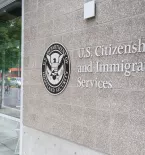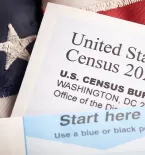
Illegal Immigration
Each year, millions of aliens deliberately violate our nation’s laws by illegally crossing U.S. borders or overstaying their visas. The problem has grown dramatically in recent years, as the number of migrants crossing the southern border has reached historic levels. Illegal immigration and the intentional disregard for the rule of law not only undermine our sovereignty but also threaten our national security and public safety. Illegal immigration also impacts our environment, harms American workers, and places a financial burden on U.S. taxpayers.
To better understand this essay, and other work published by FAIR, several commonly used terms should be defined. An alien, as defined by federal law, is any person who is not a citizen or national of the United States. An illegal alien is simply any alien who is present in the United States without legal status. In addition, while certain illegal aliens may be described as “lawfully present,” this is not the same as having legal status. For example, recipients of deferred action, deferred enforced departure, Temporary Protected Status (TPS), or parole are generally considered lawfully present, but they do not have legal status and thus they are still illegal aliens. Rather, the government has merely deferred their deportation for a period of time, and that deferral has led to them being described as “lawfully present.” Thus, when eligibility for a benefit, such as Obamacare or a driver’s license, is described as available to aliens who are “lawfully present,” this generally means both illegal aliens who are lawfully present and legal aliens may apply.
In addition, those who cross the border illegally and claim asylum are illegal aliens, even though the law permits them to request asylum pursuant to various restrictions and regulations. Some advocates have described seeking asylum as “lawful immigration.” While this may be true for aliens who come to the U.S. on visas and claim asylum, this is not true for illegal border crossers. An alien who enters illegally is still an illegal alien, whether or not he or she applies for asylum. Aliens who cross illegally and claim asylum remain illegal aliens until their case is adjudicated, which could be years down the road. Nevertheless, the law allows them to apply for work eligibility and other benefits despite the fact that they have no legal status.
While illegal immigration is not new, the recent border crisis has shown the dramatic and dangerous consequences of a catch-and-release agenda. In each of the last fiscal years (FY), a new record was set for illegal immigration in the U.S. In FY 2021, the number of illegal aliens encountered at our borders was 1.957 million. In FY 2022, the number of encounters was 2.767 million. In FY 2023, it was 3.201 million. For comparison, between 2012 and 2020, a period overlapping two different Presidential administrations, there was an average of 560,000 encounters per year.
Currently, there are no signs that illegal immigration will slow. In December 2023, U.S. Customs and Border Protection (CBP) encountered over 371,000 illegal aliens at our borders in a single month, the highest ever recorded figure. This has set the U.S. on track to have yet another record year of illegal immigration in FY 2024.
The total number of illegal aliens encountered since Fiscal Year 2020 now stands at over 9.4 million illegal encounters. In addition to those encountered, illegal aliens enter between ports of entry and evade law enforcement, with an estimated number of “gotaways” above 1.7 million since President Biden took office.
CBP classifies illegal aliens encountered at our borders into four categories 1) Single Adults; 2) Family Unit Aliens; 3) Unaccompanied Children/Single Minors; and 4) Accompanied Minors.
According to CBP, a “Family Unit” represents the number of individuals (either a child under 18 years old, parent or legal guardian) apprehended with a family member by the U.S. Border Patrol. “Unaccompanied Alien Children” are defined in statute as those, under the age of 18, who have no lawful immigration status in the United States and who do not have a parent or legal guardian in the United States available to provide care and physical custody. An “Accompanied Minor” represents a child accompanied by a parent or legal guardian and the parent or legal guardian is either a U.S. citizen, Lawful Permanent Resident, or admissible noncitizen, and the child is determined to be inadmissible.
While single adults make up the majority of encounters, there were 455,338 children (outside of family units) encountered by CBP in the last three years.

In Fiscal Year 2023, the most commonly encountered illegal aliens were Mexican nationals (735,937). Other leading countries of origin include: Venezuela (334,914), Guatemala (221,849), Honduras (216,028) and Cuba (200,287). In recent years, however, increasing number of illegal aliens are arriving from Ecuador, Haiti, China, Venezuela, and Russia.
Gotaways are illegal aliens observed to have entered the country, but ultimately succeeded in evading law enforcement or Border Patrol. As defined in statute, the term “gotaway” means an unlawful border crosser who (A) is directly or indirectly observed making an unlawful entry into the United States; (B) is not apprehended; and (C) is not a turn back. Cameras or sensors may detect an illegal alien crossing the border, but an officer may not be able to respond or apprehend the alien. They are estimates that relay on agents identifying them to the point where they cannot be apprehended. In addition to these “known gotaways,” there are untold numbers of “unknown gotaways.”
There were 1,174,385 known gotaways during the first two years of President Biden’s tenure.

While the government grants over a million green cards each year that provide permanent residence status, most visas issued are temporary in nature (i.e. nonimmigrant visas) and specify a period of time the alien may stay in the United States. For example, typical tourist or business visas (B1/B2 visa) permit aliens to stay in the U.S. no longer than six months in a given year. If an alien stays beyond that period, he or she falls “out of status.”
Unfortunately, a sizeable portion of illegal aliens in the U.S. consists of aliens overstaying their visas. While estimates have varied over the years, recent numbers suggest that visa overstays account for as much as 40 percent of the illegal alien population. According to the most recent data provided by the Department of Homeland Security, in Fiscal Year 2022, nearly 854,000 nonimmigrant visitors violated the terms of their visas and overstayed in the United States.[1] Over the past four years, the total rate of visa overstays (as a proportion of those expected to depart) has increased, up from 1.21 percent in Fiscal Year 2019 to 3.67 percent in Fiscal Year 2022.[2]
In addition to visa overstayers, aliens who do not require a visa or arrive from Visa Waiver Program (VWP) countries also overstay the allowed time. VWP nationals visiting the U.S. on business or pleasure in Fiscal Year 2022 accounted for nearly 100,000 overstays.
FAIR estimates that at least 16.8 million illegal aliens resided in the United States as of June 2023.[3] Illegal aliens impose significant costs on U.S. taxpayers – ranging from shelter, health care, educational benefits, welfare and tax credits, and incarceration costs. At the start of 2023, the net cost of illegal immigration for United States taxpayers – at the federal, state, and local levels – was at least $150.7 billion.[4]
- There are at least 16.8 million illegal aliens in the United States as of the beginning of 2023.[5]
- In Fiscal Year 2023, a record 3.2 million encounters with illegal aliens were recorded at America’s borders.
- The majority of illegal aliens are from Latin and Central America. The most commonly encountered nations of origin for illegal immigrants encountered in Fiscal Year 2023 included Mexico, Venezuela, Guatemala, Honduras and Cuba.
- Between Fiscal Year 2022-2023, there was a 60 percent increase in illegal aliens encountered in family units.
- In Fiscal Year 2023 alone, nearly 138,000 unaccompanied children were encountered at our borders. That is an average of 378 per day.
- In Fiscal Year 2022, there were 853,955 overstays, at a rate of 3.67 percent of all visitors.
- For nonimmigrants who entered on a student or exchange visitor visa (F, M, or J visa) in Fiscal Year 2022, the overstay rate was 3.5 percent. More than 9,000 Chinese nonimmigrants overstayed, accounting for more than 16% of all student and exchange overstays reported.
- Illegal migration costs the American taxpayer approximately $182.1 billion annually as of the beginning of 2023. Illegal aliens only contribute around $31.4 billion in taxes at the state and federal levels, meaning that illegal immigration costs American taxpayers a net of at least $150.7 billion annually.[6]
Illegal immigration has serious, long-lasting impacts on every aspect of American society. It undermines our sovereignty, the rule of law, public safety and imposes tremendous burdens on our immigration agencies. In particular, it exacerbates our legal system and diverts resources from serving those who seek to come to the U.S. legally.
Illegal immigration also contributes to population growth, overwhelming communities by consuming already limited affordable housing, crowding classrooms, and increasing the strain on precious natural resources like water, energy, and forestland.
Illegal immigration also impacts Americans individually; it is not a victimless crime. Americans increasingly pay more in city, state, and federal taxes to pay for illegal aliens who have spent all their savings on drug cartels who help guide them to the U.S.-Mexico border. And, as illegal immigration has increased, so has the trafficking of drugs such as fentanyl, which has killed hundreds of thousands of Americans over the past few years.
As illegal immigration increases, and illegal aliens are released into American communities without proper vetting, Americans are also increasingly becoming the victims of illegal alien crime. Americans’ identities are often stolen by illegal aliens, who use them to live, work, and remain in the country. Other Americans have tragically become the victims of violent crime, including hit and runs, assault, and even murder.
Illegal immigration also hurts U.S. workers, including those who entered the country through legal immigration channels, are harmed or disadvantaged by illegal aliens who work for less money, often driving down wages and worsening working conditions.
In order to control illegal immigration, FAIR advocates for strong border security as well as enforcement of the immigration laws on the books. Equally important, FAIR works to enact immigration reform measures that will reduce the negative impact of uncontrolled immigration on the nation’s security, economy, workforce, education, healthcare, and environment.
To download the PDF of this page click here.
Endnotes
[1] DHS Fiscal Year 2022 Entry/Exit Overstay Report
[2] Ibid.
[3] https://www.fairus.org/issue/illegal-immigration/how-many-illegal-aliens-are-united-states-2023-update
[4] https://www.fairus.org/issue/publications-resources/fiscal-burden-illegal-immigration-united-states-taxpayers-2023
[5] https://www.fairus.org/issue/illegal-immigration/how-many-illegal-aliens-are-united-states-2023-update
[6] https://www.fairus.org/issue/publications-resources/fiscal-burden-illegal-immigration-united-states-taxpayers-2023

























